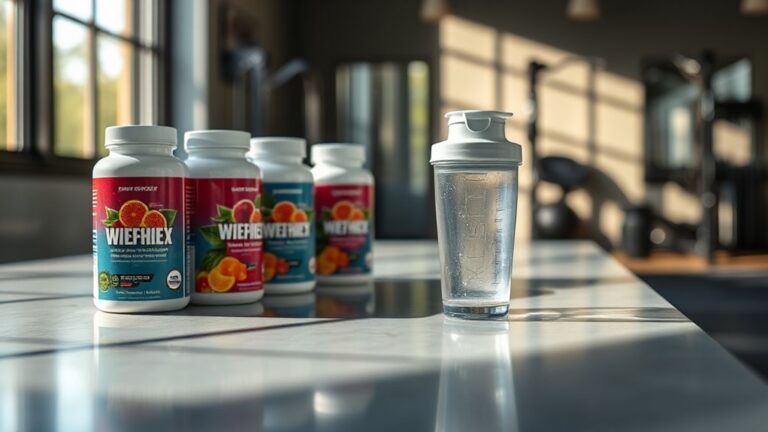The Science Behind Fat Loss vs. Weight Loss in the Gym

Understanding the distinction between fat loss and weight loss is essential in the gym. Weight loss often reflects temporary changes in water or muscle mass, while effective fat loss targets a reduction in adipose tissue, improving body composition. This process is influenced by factors like metabolism, diet, exercise type, and hormonal regulation. Prioritizing muscle mass and utilizing a caloric deficit can enhance fat loss efforts. Explore further how these elements interplay to optimize your fitness journey.
Understanding Weight Loss: What It Really Means

Weight loss often gets conflated with fat loss, but it’s essential to understand what it truly means. When you aim for weight loss, you’re generally looking to create a caloric deficit, leading to temporary weight fluctuations. However, metabolic adaptation can occur, where your body adjusts to lower caloric intake, potentially stalling progress. Psychological factors also play a significant role; your body image and emotional well-being can affect your adherence to lifestyle changes.
Hydration importance shouldn’t be overlooked, as dehydration can influence weight temporarily. Nutrient timing can optimize your workouts, supporting hormonal balance and recovery. Additionally, sleep quality is vital; inadequate rest can hinder weight loss efforts by disrupting hormonal regulation. Recognizing that weight loss encompasses various factors, including diet, exercise, and mental health, helps you approach your goals with a holistic mindset. Understanding these elements lays a solid foundation for achieving sustainable, healthy outcomes. Furthermore, incorporating activities like skipping rope can significantly enhance your calorie burn and overall fitness levels.
Defining Fat Loss: The Importance of Body Composition
To effectively assess your progress in the gym, understanding body composition metrics is essential. Focusing solely on weight can be misleading, as the balance between muscle mass and fat is what truly impacts your metabolic health and physical appearance. By distinguishing between fat and lean tissue, you can tailor your fitness regimen for the best fat loss while preserving muscle.
Understanding Body Composition Metrics
While many people conflate fat loss with weight loss, understanding body composition metrics is essential for achieving meaningful health and fitness goals. Body composition analysis provides a clearer picture of your body metrics, revealing muscle density and fat percentage rather than just total weight. This distinction is vital; a lower body fat percentage often indicates better metabolic health and healthier weight distribution. Focusing solely on weight loss can lead to muscle loss, which negatively impacts your overall fitness goals. By tracking body fat and muscle mass, you can tailor your training and nutrition to promote fat loss while preserving or increasing muscle density, ultimately leading to a more sustainable and effective approach to fitness.
Importance of Muscle Mass
Muscle mass plays an essential role in defining fat loss and overall body composition. Higher muscle mass increases your resting metabolic rate, leading to greater calorie expenditure even at rest. This metabolic adaptation is vital for effective fat loss, as it means you burn more calories throughout the day. Additionally, adequate muscle mass supports muscle recovery after workouts, allowing you to train more frequently and with greater intensity. The synergy between muscle recovery and metabolic efficiency creates a favorable environment for fat loss, as your body becomes more adept at utilizing fat as fuel. Consequently, prioritizing strength training and maintaining muscle mass should be integral to your fitness strategy to achieve ideal fat loss results.
Fat vs. Lean Tissue
Understanding the distinction between fat and lean tissue is essential for effective fat loss. Lean muscle plays a critical role in metabolism, as it requires more energy to maintain compared to fat storage. This energy expenditure helps in achieving fat loss rather than just weight loss.
| Tissue Type | Energy Storage | Metabolic Rate |
|---|---|---|
| Lean Muscle | Low | High |
| Fat | High | Low |
| Water | None | Variable |
| Bone | None | Low |
| Organs | Variable | Moderate |
Focusing on increasing lean muscle through resistance training can enhance your metabolic rate, promoting fat loss while minimizing the loss of muscle mass. This approach guarantees a healthier body composition long-term.
The Science of Metabolism: How Your Body Burns Fat
Understanding your metabolism is essential for effective fat loss, as it encompasses your Basal Metabolic Rate (BMR) and various factors influencing energy expenditure. Each macronutrient you consume can markedly alter how your body burns fat, impacting both immediate energy needs and long-term storage. By analyzing these components, you can tailor your approach to maximize fat loss while minimizing muscle loss.
Basal Metabolic Rate
Basal Metabolic Rate (BMR) represents the number of calories your body requires to maintain essential physiological functions at rest, such as breathing, circulation, and cellular production. Understanding your BMR is vital for weight management, as it reflects your resting energy expenditure. Factors such as age, gender, and muscle mass influence BMR, and metabolic adaptation can occur during weight loss, affecting your caloric needs.
| Factor | Impact on BMR | Notes |
|---|---|---|
| Age | Decreases with age | Muscle mass declines |
| Gender | Males generally higher | Hormonal differences |
| Muscle Mass | Increases BMR | Muscle burns more calories |
Energy Expenditure Factors
BMR sets the foundation for your overall energy expenditure, but several other factors contribute to how effectively your body burns fat. Energy balance plays an important role; consuming fewer calories than you expend leads to fat loss. Exercise intensity affects the calories burned during workouts, with higher intensities promoting greater fat oxidation. Metabolic adaptation can occur with prolonged caloric deficits, slowing your metabolic rate. Nutrient timing influences how efficiently your body utilizes energy, particularly around workouts. Meanwhile, recovery strategies, including proper sleep quality and hydration levels, can directly impact your metabolic function. Finally, lifestyle habits, such as stress management, greatly influence your overall energy expenditure and fat loss efficacy. Balancing these factors is essential for optimizing your fat-burning potential.
Macronutrient Impact on Metabolism
While the body requires a balance of macronutrients to function at its best, the type and proportion of these nutrients can greatly influence metabolic processes, including fat oxidation. Research indicates that specific macronutrient ratios—such as higher protein intake—can enhance thermogenesis and preserve lean muscle mass during caloric deficits, promoting fat loss. Conversely, inadequate intake of carbohydrates may lead to metabolic adaptation, where the body becomes more efficient at conserving energy, thereby slowing fat loss. This adaptation can hinder progress if not addressed. By consciously adjusting your macronutrient ratios, you can optimize your metabolic rate, ensuring that your body effectively utilizes fat as a primary energy source while supporting overall performance in the gym.
The Role of Diet in Fat Loss vs. Weight Loss
Understanding the intricate relationship between diet and body composition is vital when distinguishing between fat loss and weight loss. Achieving a caloric deficit is essential for both, but while weight loss often includes water and muscle loss, fat loss specifically targets adipose tissue. Nutrient timing and meal frequency can optimize energy balance, influencing how your body utilizes stored fat versus muscle. Prioritizing food quality over quantity helps guarantee you’re consuming nutrient-dense options, aiding in satiety and overall health. Hydration effects also play a role; adequate water intake can enhance metabolic processes. Dietary restrictions and portion control are significant, as they directly impact macro ratios and food choices. By strategically managing these factors, you can effectively differentiate between losing weight and losing fat, ultimately achieving a healthier body composition.
Types of Exercise: Cardio vs. Strength Training

When considering your exercise routine, it’s vital to understand the distinct roles of cardio and strength training in fat loss and muscle gain. Research indicates that cardio is effective for creating a calorie deficit, which is essential for fat loss, while strength training promotes muscle hypertrophy, improving your metabolism. By integrating both types of exercise, you can optimize your results in the gym. Additionally, incorporating skipping rope into your routine can enhance cardiovascular fitness and assist in effective fat loss.
Cardio Benefits for Fat Loss
As you explore fat loss strategies, it’s essential to recognize the distinct benefits of cardio exercise compared to strength training. Cardio, particularly through methods like interval training, can enhance fat oxidation and increase your metabolic rate, leading to greater fat loss. High-intensity interval training (HIIT) effectively boosts your post-exercise oxygen consumption, allowing you to burn more calories even after your workout. On the other hand, low-intensity steady-state cardio promotes fat utilization as a primary energy source, making it ideal for longer sessions. Research supports that incorporating diverse cardio methods can optimize fat loss, catering to your individual preferences and fitness levels. By understanding these mechanisms, you can tailor your workout regimen for effective fat loss outcomes.
Strength Training for Muscle Gain
While cardio is often emphasized for fat loss, strength training plays an essential role in muscle gain and overall body composition. To effectively stimulate muscle growth, you should incorporate various muscle hypertrophy techniques, such as progressive overload and compound movements. These methods promote muscle fiber recruitment and enhance metabolic adaptations.
Additionally, strength training frequency is vital; research suggests aiming for at least two to three sessions per week per muscle group to maximize gains. Balancing intensity and volume in your workouts will also optimize muscle recovery and growth. By prioritizing strength training alongside cardio, you’ll not only build muscle but also improve your metabolic rate, aiding in fat loss and achieving a leaner physique over time.
The Impact of Muscle Mass on Weight and Fat Loss
Understanding the role of muscle mass is vital for anyone looking to optimize their fat loss and weight management strategies. Increased muscle mass elevates your resting metabolic rate, meaning you burn more calories even at rest. This phenomenon is important for fat loss since a higher calorie expenditure can create the necessary deficit for weight loss. In addition, the process of muscle recovery after strength training promotes strength adaptation, leading to enhanced performance in subsequent workouts. As you build muscle, you’re not just increasing your weight; you’re shifting your body composition toward a higher ratio of lean mass to fat mass. This shift is beneficial because lean tissue is metabolically active, aiding in fat oxidation. Thus, to maximize fat loss, focus on resistance training that fosters muscle growth, while ensuring adequate recovery to support muscle repair and development. Ultimately, prioritizing muscle mass can greatly impact your overall weight and fat loss journey. Additionally, incorporating effective cardio workouts like skipping rope can further enhance your calorie burn and support weight loss efforts.
Hormonal Influences on Fat Storage and Loss

Hormones play an essential role in determining how your body stores and loses fat, influencing everything from appetite regulation to metabolic processes. To achieve ideal fat loss, maintaining hormonal balance is essential. For instance, improved insulin sensitivity helps regulate blood sugar levels and reduces fat storage. Elevated cortisol levels, often due to stress, can increase fat retention and hinder weight loss. Leptin resistance impairs satiety signals, while ghrelin regulation affects hunger, making it harder to control intake. Additionally, thyroid function is important as it regulates metabolic hormones that dictate your energy expenditure. Estrogen effects can lead to fat distribution changes, particularly in women, while testosterone influences muscle mass and fat metabolism in men. Understanding these hormonal adaptations can aid in crafting effective strategies for fat loss, emphasizing the importance of a holistic approach that considers these significant factors.
Common Myths About Weight Loss and Fat Loss
Many people mistakenly conflate weight loss with fat loss, leading to confusion about effective strategies for achieving their fitness goals. One common myth is that a caloric deficit alone guarantees fat loss, ignoring the necessity of muscle preservation. Relying solely on the scale can create scale obsession, as weight fluctuation often results from changes in hydration levels or muscle mass, not just fat loss. Additionally, fitness misconceptions suggest that prolonged calorie restriction leads to ideal fat adaptation, when, in reality, it can cause metabolic adaptation, hindering progress. Emphasizing diet variety is essential for sustainable fat loss, as monotony can lead to poor adherence. Ultimately, focusing on body image rather than numbers on the scale allows for a healthier relationship with food and fitness, ensuring long-term success in fat loss endeavors. Understanding these myths can empower you to make informed decisions on your fitness journey. Skipping rope is an effective exercise for reducing belly fat while enhancing overall fitness.
Tracking Progress: Metrics to Measure Success

While traditional weight scales can provide a snapshot of your overall mass, they often fail to capture the nuances of body composition changes that are crucial for tracking fat loss effectively. To truly assess your progress, consider using body fat percentage measurements, which can be obtained through calipers or bioelectrical impedance analysis. These methods offer a more accurate reflection of fat loss compared to weight alone.
Additionally, progress tracking through circumferential measurements—like waist, hips, and thighs—can reveal changes that scales miss. Tracking strength gains and workout performance also serves as essential success metrics, indicating improvements in muscle mass and metabolic efficiency. Moreover, monitoring your energy levels and overall well-being can provide qualitative data on your journey. By leveraging these diverse metrics, you’ll gain a thorough understanding of your fat loss progress, ensuring that your efforts align with your long-term fitness goals. Utilizing tools like the calories burned calculator can further enhance your ability to measure workout efficiency and results.
Creating a Sustainable Plan for Fat Loss Goals
To achieve sustainable fat loss, it’s essential to create a plan that aligns with your lifestyle and individual needs, ensuring that any changes you make can be maintained over time. Start with goal setting; define specific, measurable, achievable, relevant, and time-bound (SMART) objectives. Incorporate meal planning to optimize nutrient intake, making it easier to adhere to your goals. Lifestyle changes should focus on habit formation, gradually integrating new behaviors rather than overwhelming yourself with drastic alterations.
Utilize consistency techniques, such as setting regular meal times and workout schedules, to foster routine. Motivational strategies, like visualizing your success or rewarding small milestones, can enhance commitment. Establish support systems, whether through friends, family, or fitness communities, to reinforce accountability. Finally, implement progress tracking methods to assess your advancements, allowing for adjustments as necessary. This extensive approach fosters a sustainable path toward achieving and maintaining your fat loss goals. Additionally, incorporating cardio exercises like skipping can significantly aid in burning calories and improving overall fitness.
Frequently Asked Questions
Can I Lose Fat Without Losing Weight on the Scale?
Yes, you can lose fat without seeing a drop on the scale. This occurs when you’re gaining muscle while losing fat, which can improve your body composition. Muscle is denser than fat, so even if your weight remains stable, your body may look leaner and more toned. Focusing on strength training and a balanced diet can help you achieve this, as it promotes muscle gain, ultimately leading to a healthier body composition.
How Does Sleep Affect Fat Loss and Weight Loss?
Sleep quality plays an essential role in both fat loss and weight loss. When you’re sleep deprived, hormonal balance gets disrupted, leading to increased levels of cortisol and decreased leptin, which can promote hunger and fat storage. Good sleep enhances recovery and supports metabolic processes, making it easier to burn fat and maintain a healthy weight. Prioritizing quality sleep can greatly impact your overall progress and efficacy in your fitness journey.
Is Intermittent Fasting Effective for Fat Loss?
Did you know that studies suggest intermittent fasting can increase fat loss by up to 8% in just 3 months? This eating pattern restricts your eating window, which may lead to a caloric deficit. By allowing periods of fasting, your body shifts to burning fat for energy. Research indicates that intermittent fasting can improve metabolic health and promote fat loss, making it an effective strategy for those looking to shed unwanted weight.
What Role Does Hydration Play in Fat Loss?
Hydration plays an essential role in fat loss by supporting metabolic processes. When you’re adequately hydrated, your body functions at its best, which can enhance your workouts and recovery. Maintaining proper water intake can also help control appetite, as thirst is often mistaken for hunger. Implementing effective hydration strategies, like drinking water before meals and throughout the day, can boost your overall fat loss efforts by ensuring your body remains efficient in burning fat.
Should I Eat Carbs Before or After Workouts for Fat Loss?
When it comes to carbs, timing can be critical for your goals. Pre workout nutrition is essential for fueling your performance, as carbs provide the energy needed during intense sessions. Consuming them before can help maintain your intensity. On the other hand, post workout recovery is important for muscle repair and glycogen replenishment, so eating carbs afterward aids in recovery. Balancing both pre and post carb intake can enhance fat loss while supporting your workout efficiency.





